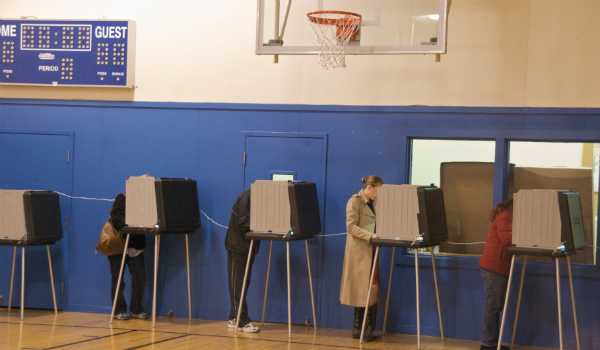
Polling place in San Francisco, CA. (Photo Credit: Steve Rhodes/Flickr)
California held a statewide election on Tuesday, but more than two-thirds of voters missed the memo. Initial vote tallies reveal a paltry 30 percent of registered voters bothered to cast a ballot. More than 18.9 million eligible Californians elected not to vote. That’s larger than the population of 46 of the 50 states.
Although many ballots remain uncounted, Tuesday’s election is on track to have the lowest turnout in a nonpresidential general election in 100 years, shattering the previous record of 50.6 percent set in 2002.
Why did so many Californians sit this one out?
With the Governor’s race a foregone conclusion (this HuffPo headline says it all), there was no heated top of the ticket race to drive voters to the polls. To be fair, relatively few, if any, compelling contests appeared on the ballot. As a result, even a handful of close down-ballot races (Secretary of State and Controller) and six interesting (but somewhat wonky) propositions failed to generate widespread enthusiasm.
I’m old school – I, unlike the majority of my fellow Californians, prefer to vote in-person rather than by mail. So as I walked through the parking lot at Monroe High School in Los Angeles to cast by ballot Tuesday night, I was struck by the lack of cars. It was practically empty.
“Where are all the voters?” I asked one of the poll workers. She estimated that only 200 of the roughly 1,000 voters in my precinct had swung by, revealing that my neighbors are as disengaged as the average Californian.
[Read my colleague’s experience volunteering as one of the election world’s often unsung heroes: A diary of a poll worker.]
I’ve been thinking a lot about the troubling trend of declining participation lately, and not just because I work at CA Fwd. Increasingly, I care more about who voted in an election than who won.
I recently attended a wedding with a guest list comprised mostly of young people (or “Millennials” in the common parlance of those who aren’t young people), who some studies say vote at lower rates than older generations. Curious if they agreed low turnout is cause for concern, I asked these 20 and 30 somethings about their voting habits. None were proud to admit they don’t vote, even despite their evident skepticism about the value of the act.
[Watch: Video: To overcome Millennial cynicism, empower them with good information]
“The game is rigged,” one said. “The elected officials only worry about themselves.” “It’s a hassle,” another said. “And I’m not sure my vote really matters.”
However, both Californians said they will definitely vote in 2016, that is, if a marijuana legalization initiative appears on the ballot (as is expected). The presidential and U.S. Senate races are also likely to boost turnout that year, but it’s unclear by how much.
It begs the question: since we can’t vote to legalize pot or for a new president on every single ballot, how can we get more Californians to the polls?
Unfortunately, there’s no quick fix. A number of solutions are required to improve California’s alarmingly low voter participation rate.
The good news is that the Future of California Elections (FoCE), a coalition of election officials, civil rights organization and election reform advocates, including CA Fwd, has been working hard to identify and promote policy solutions designed to make California’s democracy more inclusive and robust. Voters in no other state can boast having such a comprehensive statewide collaborative working to improve the electoral process with their experience in mind.
If people aren’t informed or engaged, what kind of future do we have?
Hopefully this issue doesn’t fade from the spotlight quickly now that the election is over and that it fosters public conversation about on possible solutions rather than just the problem.

